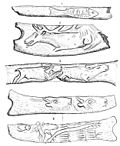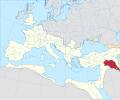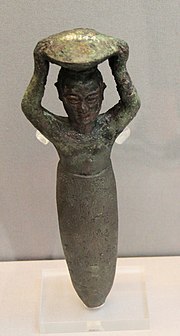The prehistory of Mesopotamia is the period between the Paleolithic and the emergence of writing in the area of the Fertile Crescent around the Tigris...
121 KB (16,409 words) - 06:59, 14 September 2024
Mesopotamia Mesopotamia is a historical region of West Asia situated within the Tigris–Euphrates river system, in the northern part of the Fertile Crescent...
90 KB (10,458 words) - 05:52, 21 October 2024
The Civilization of Mesopotamia ranges from the earliest human occupation in the Paleolithic period up to Late antiquity. This history is pieced together...
55 KB (6,381 words) - 15:50, 21 November 2024
used in discussing societies where prehistory ended relatively recently. In the early Bronze Age, Sumer in Mesopotamia, the Indus Valley Civilisation, and...
56 KB (5,895 words) - 17:42, 3 November 2024
Lower Mesopotamia is a historical region of Mesopotamia. It is located in the alluvial plain of Iraq from the Hamrin Mountains to the Faw Peninsula near...
4 KB (544 words) - 21:40, 18 December 2023
Art of Mesopotamia The art of Mesopotamia has survived in the record from early hunter-gatherer societies (8th millennium BC) on to the Bronze Age cultures...
82 KB (8,531 words) - 19:57, 1 November 2024
Mandate for Mesopotamia (Arabic: الانتداب على بلاد ما بين النهرين, romanized: al-Intidāb ʿalā Bilād mā bayn an-Nahrayn) was a proposed League of Nations mandate...
6 KB (587 words) - 09:20, 22 October 2024
This timeline of prehistory covers the time from the appearance of Homo sapiens approximately 315,000 years ago in Africa to the invention of writing, over...
81 KB (8,890 words) - 15:12, 1 November 2024
The geography of Mesopotamia, encompassing its ethnology and history, centered on the two great rivers, the Tigris and Euphrates. While the southern is...
17 KB (2,426 words) - 10:43, 12 October 2024
The architecture of Mesopotamia is ancient architecture of the region of the Tigris–Euphrates river system (also known as Mesopotamia), encompassing several...
35 KB (4,459 words) - 01:48, 17 November 2024
Upper Mesopotamia constitutes the uplands and great outwash plain of northwestern Iraq, northeastern Syria and southeastern Turkey, in the northern Middle...
26 KB (3,018 words) - 21:27, 8 November 2024
Indus–Mesopotamia relations Indus–Mesopotamia relations are thought to have developed during the second half of 3rd millennium BCE, until they came to...
77 KB (7,482 words) - 10:32, 13 November 2024
Ur (redirect from Prehistory of Ur)
Sumerian city-state in ancient Mesopotamia, located at the site of modern Tell el-Muqayyar (Arabic: تَلّ ٱلْمُقَيَّر, lit. 'mound of bitumen') in Dhi Qar Governorate...
68 KB (7,139 words) - 21:05, 19 November 2024
collapse of the Neo-Babylonian Empire in 539 BC with the Battle of Opis, that Mesopotamia was ruled again by Semitic-speaking people, after centuries of Persian...
90 KB (10,572 words) - 19:32, 20 November 2024
playing important roles in both religious and secular contexts. Mesopotamia is of particular interest to scholars because evidence from the region—which...
89 KB (10,656 words) - 03:42, 8 November 2024
Neolithic (section Southern Mesopotamia)
division of the Stone Age in Europe, Asia, Mesopotamia and Africa (c. 10,000 BC to c. 2,000 BC). It saw the Neolithic Revolution, a wide-ranging set of developments...
79 KB (8,103 words) - 18:12, 21 November 2024
Uruk period (redirect from History of Mesopotamia (4000–3100 BC))
transfer of writing from Mesopotamia to Egypt, and generated "deep-seated" parallels in the early stages of both cultures. On the cusp of prehistory and history...
124 KB (16,861 words) - 21:08, 19 November 2024
Mesopotamia was the name of a Roman province, initially a short-lived creation of the Roman emperor Trajan in 116–117 and then re-established by Emperor...
10 KB (936 words) - 15:00, 9 October 2024
Jemdet Nasr period (redirect from History of Mesopotamia (3100–2900 BC))
in Mesopotamia", Journal of World Prehistory, 6 (3): 297–336, doi:10.1007/BF00980430, S2CID 161700843 Pollock, Susan (1999), Ancient Mesopotamia. The...
15 KB (1,458 words) - 21:27, 4 October 2024
Nin-UM, who came to be absorbed by the goddess of Uruk at some point in the prehistory of Mesopotamia and lost her unknown original character in the process...
25 KB (3,311 words) - 10:45, 19 October 2024
Ubaid period (category Ancient Mesopotamia)
BC) is a prehistoric period of Mesopotamia. The name derives from Tell al-'Ubaid where the earliest large excavation of Ubaid period material was conducted...
69 KB (7,963 words) - 21:53, 5 November 2024
The prehistory of Australia is the period between the first human habitation of the Australian continent and the colonisation of Australia in 1788, which...
61 KB (7,042 words) - 08:40, 21 November 2024
The prehistory of the Iranian plateau, and the wider region now known as Greater Iran, as part of the prehistory of the Near East is conventionally divided...
19 KB (2,228 words) - 21:18, 22 June 2024
Değirmentepe (category Archaeological sites of prehistoric Anatolia)
Early Bronze Age Southwest Asia. Ph.D. Thesis. University College London. p.77 Aratashen Prehistory of the Levant Prehistory of Mesopotamia Turkey portal...
5 KB (587 words) - 01:00, 17 June 2024
The prehistory of the Levant includes the various cultural changes that occurred, as revealed by archaeological evidence, prior to recorded traditions...
23 KB (2,568 words) - 15:03, 1 September 2024
period (abbreviated ED period or ED) is an archaeological culture in Mesopotamia (modern-day Iraq) that is generally dated to c. 2900 – c. 2350 BC and...
78 KB (9,260 words) - 04:48, 7 October 2024
Egypt–Mesopotamia relations were the relations between the civilizations of ancient Egypt and Mesopotamia, in the Middle East. They seem to have developed...
53 KB (5,321 words) - 04:03, 17 November 2024
Harappa (category Culture of Punjab, Pakistan)
skeletal remains demonstrating some of the highest rates of injury (15.5%) found in South Asian prehistory. Examinations of Harappan skeletons have often found...
24 KB (2,546 words) - 07:45, 7 November 2024
Ziggurat (category Archaeology of Iraq)
ancient Mesopotamia. It has the form of a terraced compound of successively receding stories or levels. Notable ziggurats include the Great Ziggurat of Ur...
16 KB (1,782 words) - 19:00, 16 October 2024
Near East they are concentrated in less arid regions, including Upper Mesopotamia, the Southern Levant, Anatolia and Iran, which had more continuous settlement...
22 KB (2,102 words) - 03:48, 21 October 2024
























